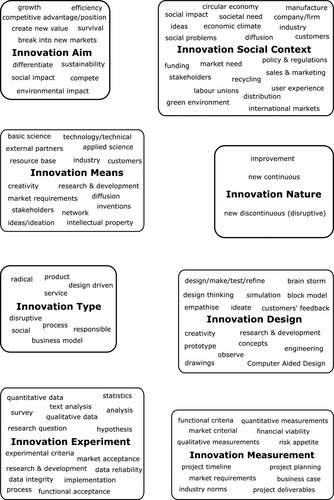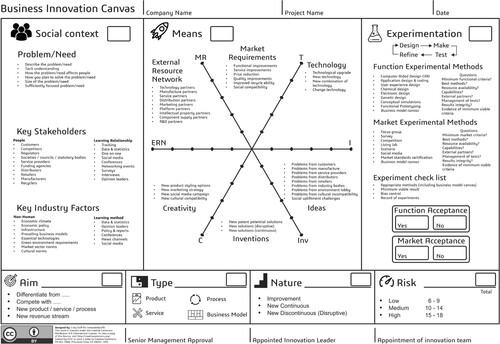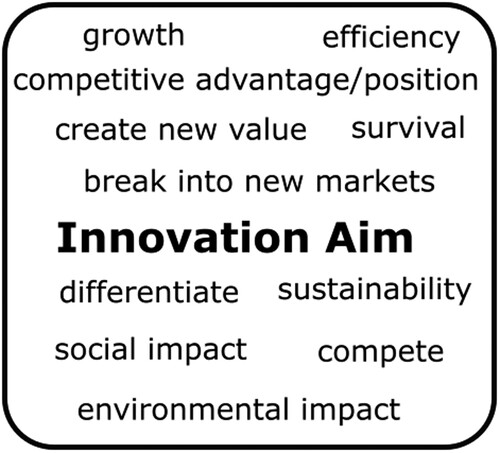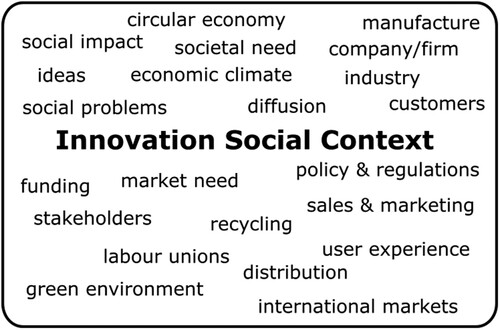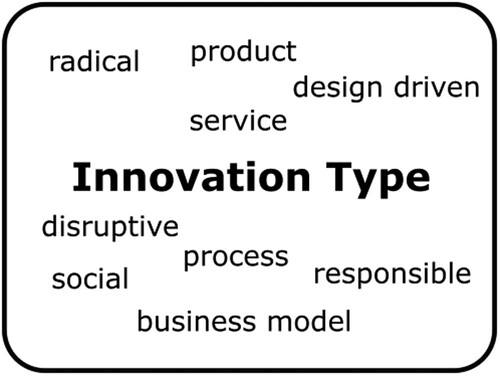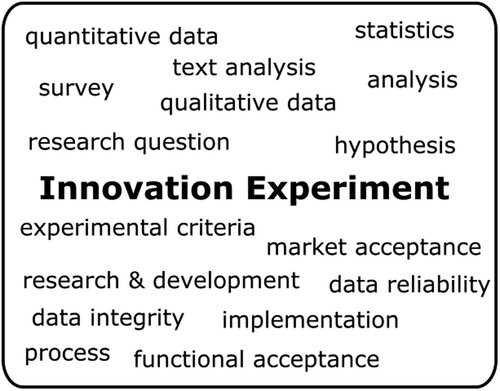Abstract
In this conceptual work, we describe cross-disciplinary meaning and language related to the innovation phenomenon located in a business context. Our work attempts to find common meaning and language for innovation that can be applied across all business innovation projects irrespective of the business discipline, and to synthesize these common terms into an innovation communication and planning tool. The objective of providing a common meaning and language for innovation is to give practitioners, researchers, and stakeholders a shared communication platform, and common language and meaning that assist incumbents to discuss and collaborate during innovation projects without the boundaries created by siloed, nuanced, and discipline-specific understandings. The outcome of the paper is a conceptual framework and canvas tool constructed from universal meaning and language for business innovation with the aim of providing a set of common questions that business practitioners could ask during times of innovation. Furthermore, the Business Innovation Canvas provides new directions for future study and the development of tools that take advantage of common meaning and language to aid innovation practitioners and researchers.
Introduction
The language used to describe and define innovation is problematic because the words and phrases have multiple meanings (Linton Citation2009, 729–737). Each context provides different meanings for the established words in the language of innovation, and these meanings are often not shared across discipline boundaries (Baregheh, Rowley, and Sambrook Citation2009, 1323–1339). This lack of common meaning creates confusion, which leads to poorly executed innovation projects. These contextual differences in meaning result in poor communication, inefficiency, ineffective allocation of resources, ambiguous priorities, and a higher potential for unsuccessful innovation projects (Phillips Citation2014, 17). As Hobcraft (Citation2018, 10) implores, ‘Forming a common language should be the bedrock of how we set about innovation.’ A common language for innovation helps build robust innovations, and language repetition builds common meaning in praxis. A common innovation language unites our efforts; in contrast, language that is unique and uncommon divides and fragments innovation efforts (Hobcraft Citation2018, 10).
Research on innovation in business has attracted significant attention in recent decades, driven by the ever-increasing need for companies to use innovation as a means to maintain and grow their competitive advantage (Govindarajan and Trimble Citation2010, 1–206; Prajogo Citation2016, 241–249; Lüdeke-Freund Citation2020, 665–681). However, most of the research is nuanced, focusing on narrow topics, discipline-specific challenges and environments, which helps entrench discipline-specific meaning and language for innovation. This conceptual paper traces cross-disciplinary meaning and language for innovation in a business context across multiple research topics and perspectives. The cross-disciplinary framework has been extracted from definitions, models and studies related to meaning and language for innovation. According to Gilson and Goldberg (Citation2015, 127–130), a conceptual paper falls ‘beyond summarising recent research; manuscripts should provide an integration of literatures, offer an integrated framework, provide value-added, and highlight directions for future inquiry. Papers are not expected to offer empirical data.’ They further argue that the focus of a conceptual paper ‘is on integration and proposing new relationships among constructs.’
Words, phrases and concepts were extracted from published academic studies on innovation, which typically describe models and definitions of innovation. Works that discuss the language of innovation were also included. The extracted words, phrases and concepts were grouped under key headings, thus creating the conceptual framework. The conceptual framework was a first step, positing only a few key headings around which a basic common language for innovation might develop. The next section briefly describes the existing works on innovation models, definitions and innovation language from which the words, phrases and concepts were extracted.
Models of innovation
Numerous authors have discussed the evolution of innovation models over time (Žižlavský Citation2013, 47). Ceravolo, Polenakovik, and Dzidrov (Citation2016, 23–26) summarize innovation models over time and suggest that they could be divided into six generations. Their study tracks the evolution of innovation models, from simplistic early models to complex sixth-generation models that best represent the current complex systems of innovation. Early models tended to describe innovation as a simplistic process applicable across industries and nations, such as the first- and second-generation models described by Rothwell (Citation1994, 7–31) ( and ).
Figure 1: First-generation innovation process (Rothwell Citation1994, 8).

Figure 2: Second-generation innovation process (Rothwell Citation1994, 9).

The third- and fourth-generation innovation models then began to focus on the finer micro-level activities of individual companies (Rothwell Citation1994, 7–31) ( and ).
Figure 3: Third-generation innovation process (Rothwell Citation1994, 10).
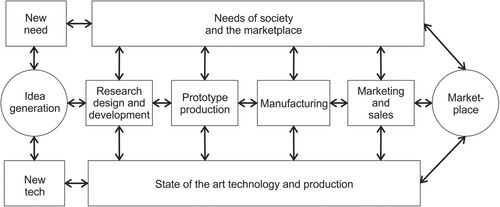
Figure 4: Fourth-generation innovation process (Rothwell Citation1994, 12).
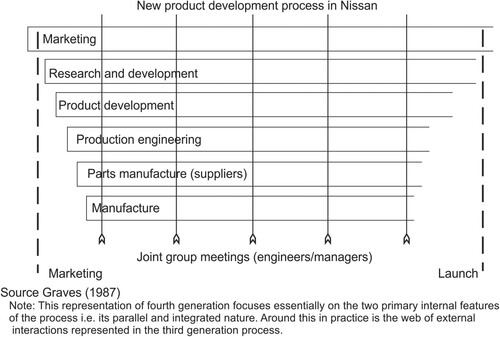
The appearance of fifth-generation models coincided with the rapid expansion of personal computing and the Internet. Access to the computing power and information and communication technology of the Internet profoundly changed the ways in which innovation models operate.
The fifth- and sixth-generation models relied on computing, connectivity and collaboration, leading to open innovation models (Chesbrough Citation2010, 354–363) ( and ). More recently, innovation models have viewed the innovation process not only at company level, taking into account surrounding networks of collaborators, but also from the perspective of the individual actor or entrepreneur, placing more emphasis on key individuals and bringing to the fore their central roles in the process of innovation (McFadzean, O'Loughlin, and Shaw Citation2005, 350–372; Shaw, O'Loughlin, and McFadzean Citation2005, 393–408; Duff Citation2019, 1–226). Words and terminology have been used to describe innovation models throughout the evolution of such models. Often words or terms with similar meanings have been repeated as the models progressed, with the addition of new words and terms that span the macro-level (), micro-level () and individual-level concept evolutions for models of innovation; for example, the innovation leadership model proposed by Duff (Citation2019, 197) ().
Figure 5: Fifth-generation innovation process (Rothwell Citation1994, 27).

Figure 6: Chesbrough’s open innovation model (Chesbrough Citation2012, 23).
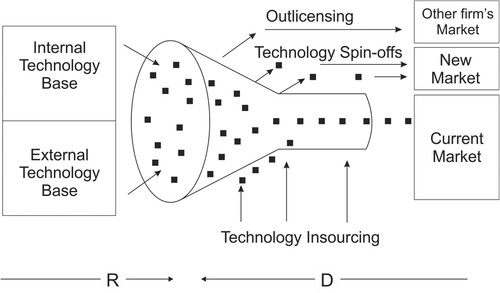
Figure 7: Macro-level model (Shaw, O'Loughlin, and McFadzean Citation2005, 395).
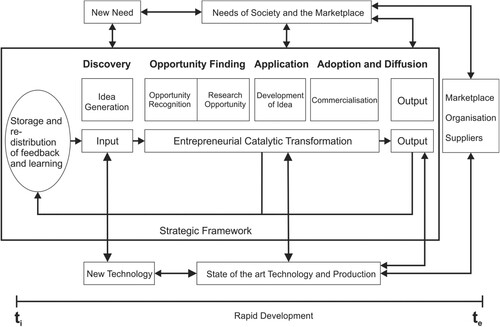
Figure 8: Micro-level model (Shaw, O'Loughlin, and McFadzean Citation2005, 397).
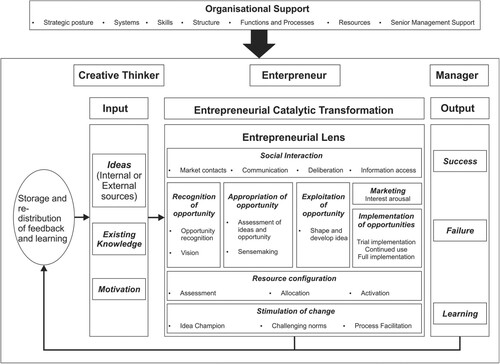
Figure 9: Innovation leadership model (Duff Citation2019, 197).
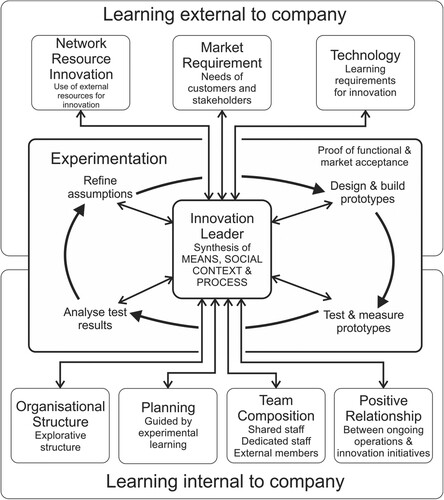
Tidd (Citation2006, 1–16) places great emphasis on the role of development and diffusion (market acceptance) in models of innovation. His study suggests that greater clarity is required in dialogue and meaning for innovation language related to market acceptance in order to provide common language and meaning for the later stages of innovation projects. Eveleens (Citation2010) looks at innovation models from a process perspective. Žižlavský (Citation2013, 47) summarizes the development of innovation models and mirrors similar studies on this topic. In particular, the study discusses companies that create innovation networks. Such networks rely on developing common language and meaning to collaborate and succeed, thereby protecting their competitive position.
Zartha et al. (Citation2020, 175) differentiate innovation models from innovation management models, in that innovation models are focused on the process of innovation, whereas innovation management models are focused on the management of organizational structures supporting the development of innovation. Their study found no clear elements to describe innovation management models that organize and support innovation. This provides further evidence of the need for a common understanding of innovation language related to the development of innovation management models to support the innovation process.
Studies of innovation language
Studies related to innovation meaning and language acknowledge that terminology is often confusing and lacks universally accepted interpretations that can be applied across all business disciplines. Linton (Citation2009, 729–737) and Harmancioglu, Droge, and Calantone (Citation2009, 229–263) observe that the point of view held by practitioners and researchers contributes to confusion and ambiguity with respect to innovation terminology and meaning. Linton (Citation2009, 729–737) argues that one’s point of view is crucial to the meaning ascribed to the language and terminology applied to innovation, and that each firm has its own unique culture and perspective, which directly influence the meaning of innovation terms such as those used to describe the nature of innovation. To illustrate his argument, Linton constructed a two-axial framework describing the relationship between technical and social innovation (). This continuum of technical and social relationships demonstrates how vast differences in the perception and understanding of innovation terminology could occur.
Figure 10: Technical and social innovation continuum (Linton Citation2009, 730)
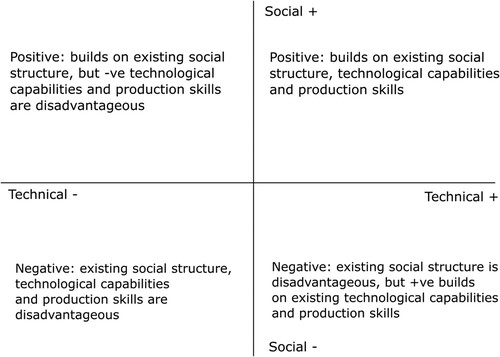
Harmancioglu, Droge, and Calantone (Citation2009, 229–263) offer three dimensions through which academic studies of innovation can be understood, namely theory, level and perspective ().
Figure 11: Dimensions of academic study of innovation (Harmancioglu, Droge, and Calantone Citation2009, 229–263).

Egbetokun et al. (Citation2017, 25) further demonstrate how meaning and language for systems of innovation differ in developing countries, with modifications differentiating the meaning and language of studies in developing countries from those in developed countries.
Edwards-Schachter (Citation2018, 65–79) acknowledges the importance of capturing a comprehensive picture of innovation to overcome terminological babelization and fragmentation in this field of research. This article argues that the nature of innovation is related to novelty, and many types of innovation have proliferated in recent decades. These types include technological innovation, product innovation, process innovation, service innovation, business model innovation, disruptive innovation, radical innovation, design-driven innovation, social innovation and responsible innovation.
Hernández et al. (Citation2018, 249–274) argue that design language is the language of innovation, and that innovation projects have adopted communication based on visual tools, design development techniques and design research methods. They demonstrate how design language has contributed to innovation at the ideation, development and implementation stages. Their analysis describes how the language of design is applied in these three stages through the various concepts of design, such as design to differentiate; design to introduce and facilitate adoption of innovation in the market; design as research; design to transform ideas into concepts; design as a technique to articulate ideas and to integrate concepts, people and function; and design as a creative generative thinking process. Furthermore, Tacchella, Napoletano, and Pietronero (Citation2020, 1–20) describe how data scientists use the language of innovation to predict future innovation trends by collecting innovation language used in patents to develop a forecasting method.
Definitions of innovation
A plethora of academic work has contributed definitions related to innovation in various business contexts. Kogabayev and Maziliauskas (Citation2017, 59–72) demonstrate how differing views impact on the meaning of innovation in different contexts, often leading to contradictions in the conclusions presented by different theoreticians. Their article calls for the streamlining of meaning and understanding to help build commonality in the interpretation of innovation theory.
In addition to the many business-based definitions, some studies have attempted to review these extant definitions and identify common trends. To avoid duplicating the existing body of work, this paper references the work of Baregheh, Rowley, and Sambrook (Citation2009, 1323–1339), who provide a multidisciplinary definition of business innovation. Their study demonstrates the fragmented nature of the definition of innovation used by various business disciplines. They recommend the need for common meaning, arguing that shared understanding is essential to the practice of innovation as it becomes an increasingly transdisciplinary activity.
Baregheh, Rowley, and Sambrook (Citation2009, 1323–1339) reviewed 60 definitions of innovation in the seven business disciplines, namely business and management, economics, organizational studies, innovation and entrepreneurship, technology, science and engineering, knowledge management and marketing (). Their work presents a single multidisciplinary definition and a diagrammatic representation of how the definition could be applied:
Innovation is the multi-stage process whereby organisations transform ideas into new/improved products, services or processes, in order to advance, compete and differentiate themselves successfully in their marketplace. (Baregheh, Rowley, and Sambrook Citation2009, 1323–1339)
the stages of innovation, describing the steps in the innovation process
the social context of innovation, relating to the social entity and environmental factors that influence innovation
the means of innovation, identifying the resources required for innovation to occur
the nature of innovation, determining whether an innovative change is new or an improvement
the type of innovation, describing the innovation output (e.g., product, service, process or technical)
the aim of innovation, focusing on the results that the firm wants to achieve from innovation.
Figure 12: Components of a multidisciplinary innovation approach (Baregheh, Rowley, and Sambrook Citation2009, 1333).
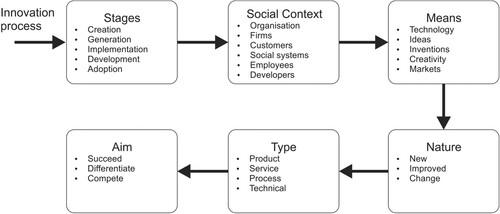
Table 1: List of sources for definitions of innovation (Baregheh, Rowley, and Sambrook Citation2009, 1328).
Table 2: Results of innovation content analysis (Baregheh, Rowley, and Sambrook Citation2009, 1330).
Table 3: Summary of word frequency (Baregheh, Rowley, and Sambrook Citation2009, 1331).
In summary, words, phrases, and concepts that stem from models, definitions, and studies of innovation language, and have universal application in innovation activities, were selected for the conceptual framework. Models, definitions, and language studies of innovation all use words and phrases as labels. These ‘label words’ were used as building blocks and grouped to form the key headings of the conceptual framework.
Conceptual framework
The development of a conceptual framework is not intended to create a glossary of terms for innovation language. Instead, the conceptual framework establishes a foundation of key headings used by innovation models, definitions, and language studies. The conceptual framework is not an exhaustive summary of words and phrases used in innovation but is instead intended as an initial step in building a common language that could be used by practitioners, researchers, and stakeholders of innovation projects. Providing a simple conceptual framework was the first step upon which a more complex and diverse common language for innovation could be developed over time. The key headings selected from the literature to build a common foundation are illustrated in , namely aim, social context, means, nature, type, experiments, design, and measurement.
The conceptual framework was further applied by presenting these key headings and common terms/language in the form of a canvas tool. The single page visual language of canvas tools has been successfully applied in other business disciplines, most notably the generation of new business models, such as the Business Model Canvas developed by Osterwalder, Pigneur, and Tucci (Citation2005, 1–25).
The conceptual framework and Business Innovation Canvas contribute to the work of practitioners by providing common language and meaning, helping them to enrich the quality and transparency of stakeholder engagement during innovation projects (). Furthermore, the conceptual framework and Business Innovation Canvas also contribute to the work of educators by helping to provide novice innovators, businesspeople, and entrepreneurs with a common language of innovation with which to engage during innovation projects.
Access to download and use the Business Innovation Canvas is provided at https://www.innovate4profit.co.za.
Tutorials explaining the use of the Business Innovation Canvas are available at https://www.youtube.com/channel/UCTzRAYijUQm9WmNr_BLmrjw.
Innovation aim
The aim of innovation describes the result that the firm wants to achieve (Chesbrough Citation2010, 354–363; Teece Citation2010, 172–194; Zott, Amit, and Massa Citation2011, 1019–1042; Bucherer, Eisert, and Gassmann Citation2012, 183–198) (). The business must know the aim of the innovation project in order to plan, commit resources, assign staff and collaborators, measure innovation and evaluate the strategic opportunities. The aim of an innovation project is fertile ground for confusion and misinterpretation, as demonstrated by Linton's (Citation2009, 729–737) relational continuum between technical and social innovation (). Linton argues that the source of confusion is a matter of perspective. The unique perspective of the firm and its description of the aim of the innovation project, through the use of language common to the firm, has the potential to confuse and mislead internal and external partners and collaborators. This language barrier could lead to inefficiencies and even costly mistakes unless all stakeholders share a common understanding of the aim of the innovation project. Moreover, all stakeholders should engage in discussion about the aim of the innovation project to dispel dissenting views, build consensus and reach common meaning for the aim of the innovation project. Dialogue about the aim of innovation projects implies that the aim cannot be set by an individual or senior management alone but should be set in consultation with all parties involved to build consensus and common meaning. The innovation aim should be precise and stated up front through collective dialogue. Dialogue in the format of questions and responses might assist stakeholders to engage and build consensus for the aim of the innovation project. The following questions are examples that could assist the business to conduct productive dialogue to identify and set the innovation aim:
Are you innovating to survive, as your current offerings are failing and you are losing market share?
Are you innovating to adapt to changing customers, market, or technology requirements?
Are you innovating to break into new markets?
Are you innovating to unlock the hidden potential that is latent in your company?
Are you innovating to survive in challenging economic conditions?
Are you innovating to improve your company's internal processes?
Are you innovating to keep one of your products relevant and ward off growing competition from your competitors?
Are you innovating to offer new services to your customers?
Are you innovating by providing a new business model to your customers?
Are you innovating to create environmentally sustainable solutions?
Are you innovating to solve social problems?
Are you innovating to make administrative improvements in your organization?
Innovation social context
The social context of innovation ‘[r]efers to any social entity, business organization, system or group of people involved in the innovation process and the environmental factors affecting it’ (Baregheh, Rowley, and Sambrook Citation2009, 1323–1339) (). The social context of innovation is complex and continually changing, filled with known and unknown challenges, agents and factors that are both internal and external to the firm. The known and unknown challenges within the social context of innovation provide a vast range of problems and opportunities that require solving. Some problems are obvious and well known, while others are hidden and often only known to individuals with specialized knowledge or insight into unknown contextual problems. Solvable problems manifest themselves inside and outside organizations and are uniquely influenced by agents (people) and factors (environment) leading to multiple interpretations of the problem and potential solutions. The known and unknown agents (people) are the catalysts and driving force behind innovation, constantly designing and altering their circumstances and environment to improve or solve problems they might experience. Not all known and unknown agents work for financial gain. Innovation within a social context for financial gain is only one dimension of all innovative endeavour. In the dimension of innovation for financial gain, known and unknown agents engage, observe, and learn from the social context in order to uncover problems or opportunities with commercial potential. The known and unknown factors of the environment, such as economics, politics, resource distribution and access to skilled labour, constantly influence problems and opportunities; for example, the problem of climate change creates the need for product, service and process solutions that do not contribute to global warming.
The combinations of challenges (problems/needs), agents (people) and factors (environment) are an ever-expanding source of innovation, requiring people to constantly observe, question and learn from their social context to uncover problems and opportunities that require new and improved commercial solutions. Engagement with the social context is essential for innovation and thus a key concept in the common meaning and language of innovation.
Innovation means
Within the context of this paper, the term means ‘[r]efers to the necessary resources (e.g., technology, creativity, market requirements) that need to be in place for innovation’ (Baregheh, Rowley, and Sambrook Citation2009, 1323–1339) ().
From the 1950s until the 1990s, the prevailing means of innovation were ‘technology push’ and ‘market pull’, starting with the ‘technology push’ of the 1950s, which was later replaced with the ‘market pull’ means of innovation. The fifth-generation innovation process model (Rothwell Citation1994, 7–31) and the sixth-generation open innovation model (Chesbrough Citation2012, 20–27) describe the emergence of a new means of innovation that has not yet been fully understood or definitively described. The new means of innovation can be described as collaborative, network or open-source innovation (Chesbrough Citation2012, 20–27). The ‘technology push’ means of innovation relied on scientific advances, requiring an internal research and development team to create new products and services from scientific discoveries (Rothwell Citation1994, 7–31). The ‘market pull’ means of innovation emerged as technologies matured and were no longer changing or introducing new technology. The market demand required less scientific research and development resources and more market-facing resources to understand market requirements and implement these as new products and services (Rothwell Citation1994, 7–31).
Due to the need to improve the efficiency of the innovation process, to achieve more with less, and to respond more rapidly to ever-changing market conditions, extensive research and development teams and marketing departments in a growing range of business contexts were no longer sustainable. Companies networked and shared intellectual property for mutual benefit (Rothwell Citation1994, 7–31; Chesbrough Citation2012, 20–27). The network means of innovation can be beneficial because development costs are spread across multiple companies using the same intellectual property building blocks (Chesbrough Citation2012, 20–27) to help each company achieve its innovation objectives.
The multidisciplinary definition of innovation (Baregheh, Rowley, and Sambrook Citation2009, 1323–1339) describes the technology, ideas, inventions, creativity and market as the means (attributes) used in the innovation process. Rothwell (Citation1994, 7–31) emphasizes the technology and market means of innovation, as these were observed over time to play a primary role in the way in which innovation was achieved. This study presents the means (technology, ideas, inventions, creativity, market, and the emerging concept of networks resources) as collectively necessary to the innovation process. The means in this group all play a role in the innovation process; some play a small part, others a significant role, and one plays a primary role. The means concepts are best represented in a radar chart ().
Figure 18: Radar chart representation of the means attribute (Duff Citation2019, 78).

This radar chart representation helps illustrate how to think about the means concepts of the innovation process. The means concepts each have relationships of varying size to the other means around the central axis. The connections between the means concepts are not static, and the importance of each concept changes over time based on the company's internal and external context, as observed by Rothwell (Citation1994, 7–31) and Chesbrough (Citation2012, 20–27).
Innovation nature
The nature attribute of the multidisciplinary definition of innovation differentiates new innovation from improved innovation (Baregheh, Rowley, and Sambrook Citation2009, 1323–1339) (). Improved innovation requires some development of an existing product, service or process. New creation requires introducing something new (product, service or process) (Christensen, Raynor, and McDonald Citation2015, 1–11).
New innovation can be further divided into two critical groupings from a business perspective: continuous innovation and discontinuous innovation (or change innovation). Continuous or incremental innovation occurs when new products, services, processes or business models are developed based on their predecessors or existing markets (Morris Citation2013, 5–10). It allows a business to stay abreast of its competitors by offering competing solutions to customers. Change, discontinuous or disruptive innovation occurs when a business provides an entirely new product, service, process or business model for new or existing markets. The company is pioneering a never-before-seen product, service, process, or process business model (Morris Citation2013, 5–10).
The profit potential and lifespan differ between different types of innovation (). Profit potential and risk are lowest for improvement innovation; they increase for continuous innovation and are highest for discontinuous innovation (Duff Citation2019, 1–226). The lifespan is shortest for improvement innovation, and most extended for discontinuous innovation. This implies that more regular investment in improvement innovation is required to reinvigorate profit, while discontinuous innovation is likely to survive with the most prolonged intervals between investments (Duff Citation2019, 1–226).
Figure 20: Nature of innovation (Duff Citation2019, 18).
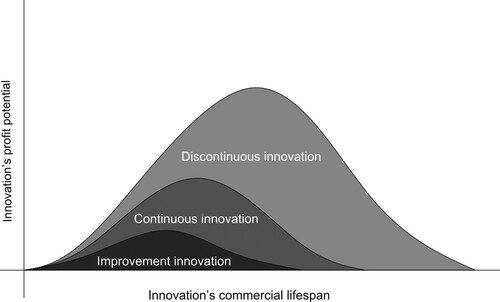
Innovation type
The type of innovation describes whether to innovate with a product, service, process, business model, or combination of these four types (). Defining the innovation type is a vital planning tool because each type has unique challenges and requirements (Lee and Evans Citation2012, 74–88). It is also essential to understand the distinctions between the four types of innovation, namely:
Products are tangible physical objects that are manufactured and sold, such as vehicles.
Services are a broad range of intangible non-physical actions, events or experiences, such as servicing one’s car.
Processes are a sequence of events that may be internal or external to the company, such as the manufacturing process or service-delivery ecosystem.
Business model innovation allows the company to tailor-make the best methods of extracting maximum value from its innovation projects.
Business model innovation is a subset of process innovation. Special attention has been paid to this particular form of process innovation because of the significant positive effect it provides to the commercial value extraction opportunities of innovation projects (Morris Citation2013, 5–10). The pairing of product, service and process innovation with business model innovation has been crucial for achieving market adoption and value extraction. In all innovation projects, the company should explore multiple business models as part of the innovation process. When the innovation process focuses on a product, service, process or a combination, the business model can provide a possible strategy for extracting maximum value in the future. If a business explores product/service/process innovation without reviewing its associated business model, the failure rate increases because both are inextricably part of the market response. In other words, the intended business model should align with the latest innovation.
Innovation design
Life can be viewed as a series of design challenges. Humankind has overcome most of these challenges by actively becoming designers and solving problems through design and experimentation. Given today's complexity, contemporary issues and solutions often require specialized knowledge and skills for effective design ().
Lawson (Citation2005, 1–227) clarifies how designers think and what design processes they follow, noting that the design process is unique each time it is used, as problems and solutions constantly change and evolve. He identifies three common activities in all design and experimentation processes, namely analysis, synthesis and evaluation, which do not follow a specific sequence. Designers often use analysis, synthesis and assessment in an unstructured and unique manner, which leads to frequent refining and restating of the problem and solutions (Lawson Citation2005, 1–227).
Design and design thinking develop experimental solutions in ill-defined and complex environments (Dorst Citation2011, 521–532; Johansson-Sköldberg, Woodilla, and Çetinkaya Citation2013, 121–146). The findings of Liedtka (Citation2014, 925–938) confirm the importance of design thinking as a management practice requiring increased attention from scholars. Design thinking methodologies assist business decision-makers to improve the outcomes of the innovation process, while contributing to more robust and relevant experiments and innovations (Liedtka Citation2014, 925–938).
The notion that business leaders and designers view the world from different and opposing viewpoints is supported by the work of Martin (Citation2007, 6–12), who states, ‘The reliability orientation of business leaders versus the validity orientation of designers creates a fundamental tension.’ Business leaders are trained to implement measures that lead to predictable profit, whereas designers are trained to empathize with the user, thereby designing solutions that are responsive to their needs (Martin Citation2007, 6–12).
In creating reliable profit, business leaders measure variables that are easy to quantify and compare with previous data to predict future yield, often referred to as linear regression (Martin Citation2007, 6–12). Conversely, designers focus on validity, seeking deep insights about the user and contexts, and accepting many ill-defined variables, comfortable that future evidence will support their design choices that have emerged from the design process (Martin Citation2007, 6–12). To create a productive relationship between designers and business executives, Martin (Citation2007, 6–12) offers five pieces of advice: appreciate that different points of view are legitimate; empathize with the unfriendly elements of the other's domain; learn to speak the other's language (the language of validity or the language of reliability); use tools that are familiar to the other's domain; and reach out of one's comfort zone to the comfort zone of the other to generate proof (designers) and give innovation a chance to grow (business executives) (Martin Citation2007, 6–12).
Design methods provide the activities, choices and results that move ideas to successful innovation (Ravasi and Stigliani Citation2012, 464–488). Design management defines a set of routines that explore the unknown, seek the truth about possible innovative solutions, provide evidence and industrialize winning solutions for commercialization (Martin Citation2007, 6–12; Cui Citation2011, 1–140; Bingham, Furr, and Eisenhardt Citation2014, 29–35).
Innovation experiment
Business experimentation allows companies to investigate causality, looking beyond correlation, and it is an essential attribute for business innovation (). Various studies emphasize its importance, indicating how business experimentation could be applied universally to all innovation projects irrespective of the business discipline (Thomke Citation2020, 40–48; Duff Citation2019, 1–226; Lindholm-Dahlstrand, Andersson, and Carlsson Citation2019, 591–610; Denning Citation2014, 3–9; Govindarajan and Trimble Citation2010, 1–206).
The ability to conduct and learn from experimentation is essential for the design team to move from an idea towards a tangible outcome. The process should pose and test hypotheses scientifically, only adjusting the hypothesis in response to evidence through experimentation. Govindarajan and Trimble (Citation2010, 1–206) present four essential principles of innovation experiments, namely:
developing and recording a well-defined assumption or hypothesis
developing a method for conducting the experiment
conducting measurement and analysis of the experiment
producing a record of the learning that resulted from the experiment.
These four principles describe the process required to construct new knowledge and organizational learning. Although the business experimentation process might use techniques borrowed from academia, the business context has an ever-present economic imperative that drives the efficient use of resources to achieve results in a rapid, cost-effective manner. Lengthy literature reviews, well-written articles, dissertations, theses, defences of the methodological approach, and an extensive reference list rarely feature in business innovation experiments. Business innovation experiments predominantly focus on application rather than exploring or explaining underlying theories.
Nothing new or improved can be developed by innovation in business without disciplined business experiments designed to demonstrate functional and market acceptance (Thomke Citation2020, 40–48; Duff Citation2019, 1–226; Lindholm-Dahlstrand, Andersson, and Carlsson Citation2019, 591–610; Denning Citation2014, 3–9; Govindarajan and Trimble Citation2010, 1–206). Successful innovations are primarily the result of controlled business experimentation (Thomke and Manzi Citation2014; Govindarajan and Trimble Citation2010, 1–206). The ability to conduct and learn from experimentation is essential for the innovation project to move from an idea to a successful commercial outcome. Experimentation is a critical mechanism when businesses translate new knowledge into economic value and business sustainability (Lindholm-Dahlstrand, Andersson, and Carlsson Citation2019, 591–610). New knowledge created by external sources (such as technology or design ideas) often leads to a more experimental approach when compared with an in-house innovation approach (Dell'Era, Marchesi, and Verganti Citation2010, 12–23). Experimentation evaluates the ideas on which assumptions are based, providing evidence to determine which assumptions are false and which are true (Thomke Citation2020, 40–48).
Innovation measurement
Within the business realm, design and product innovation face the challenge of overcoming concerns related to uncertainty and risk. Design leaders continually attempt to ‘maximise desirable and minimise undesirable uncertainties’ within their design process (Rajabalinejad and Spitas Citation2012, 50–61). Using this principle, a framework for coping with uncertainty is developed (Rajabalinejad and Spitas Citation2012, 50–61). This quantitative approach helps measure uncertainty and strategically aids design management to inform decision-making (Rajabalinejad and Spitas Citation2012, 50–61) (). An investigation of external sources of uncertainty in the design process uses design management principles to quantify the effect of external uncertainty. The study by Rajabalinejad and Spitas (Citation2011, 52–67) presents tools for dealing with external uncertainty through the various stages of the design process. Ambiguity and volatility are important variables in uncertainty (Carson, Wu, and Moore Citation2012, 1061–1081). Analysis of these conflicting variables leads to greater understanding of uncertainty, allowing management to adjust the impact of these variables on new product development (Carson, Wu, and Moore Citation2012, 1061–1081). The ways in which design practices differ between poor and wealthy countries show that design strategies, project requirements, negotiation behaviour and information behaviour also differ (Jagtap et al. Citation2014, 1–32). Understanding these differences may be useful in explaining strategic design practice in the South African context.
Innovation is the process of selling new or improved products, services or processes to the target market. Innovation implies that both quantitative and qualitative experimentation should be used. Quantitative experiments measure functional acceptance of the new or improved product, service or process, whereas qualitative experiments measure and understand market acceptance by considering the needs, problems and willingness of the target market to purchase the company's innovation. The fields of design (Ravasi and Stigliani Citation2012, 464–488), design thinking (Dorst Citation2011, 521–532), and design management (Fernández-Mesa et al. Citation2013, 547–565) contribute to experimentation by providing numerous design techniques (Aken Citation2004, 219–246). The design field offers a range of prototyping techniques for testing assumptions (Gerber and Carroll Citation2012, 64–84; Marion and Simpson Citation2009, 561–587; Bogers and Horst Citation2014, 744–764). Prototypes provide opportunities to use quantitative and qualitative measurement, analysis and reporting of results (Gerber and Carroll Citation2012, 64–84; Marion and Simpson Citation2009, 561–587; Bogers and Horst Citation2014, 744–764). Computer-aided design (CAD) enables rapid digital prototyping and has significantly reduced the cost and time required to move conceptual developments forward (Marion and Simpson Citation2009, 561–587; Bonnardel and Zenasni Citation2010, 180–191). CAD provides an ever-growing range of analysis conducted on computer-generated solid models and assemblies, presenting measurement results within minutes or hours (Marion and Simpson Citation2009, 561–587; Bonnardel and Zenasni Citation2010, 180–191).
A significant challenge to innovation experimentation is the ever-present risk of bias (Gillier and Piat Citation2011, 238–252; Liedtka Citation2014, 925–938; Behrens and Ernst Citation2014, 361–374). As with all experimentation, the researchers’ influence on the tangible results of experiments requires monitoring and consideration. Reporting on the risk of bias helps validate experimental findings and points out their limitations. The business innovation environment could learn from validity and reliability strategies employed in academic research. Govindarajan and Trimble (Citation2005, 47–76) emphasize that it is necessary to conduct strategic experiments that move innovation projects forward. At the same time, the productive use of resources and effort should contribute to organizational learning that produces market innovation (Tuulenmäki and Välikangas Citation2011, 28–35; Desouza et al. Citation2009, 6–33; Govindarajan and Trimble Citation2005, 47–76; Moultrie, John Clarkson, and Probert Citation2007, 335–368; Biazzo Citation2009, 336–353; Peterson Citation2013, 1–58). Experimentation for innovation requires creating and recording hypotheses and methods to conduct relevant experiments, measurement and analysis techniques, as well as appropriate forms of recording the findings and rigour in limiting the effect of bias on the results.
Conclusion and future research
The intention of the conceptual framework was to establish a cross-disciplinary language and canvas tool for innovation projects in the business realm. The conceptual framework groups innovation language into meaningful categories that emerged from the review of published academic literature. The categorization of innovation language aids the development of the Business Innovation Canvas, providing practitioners and stakeholders with a simple visual tool with which to express, discuss and refine innovation projects. The purpose of the Business Innovation Canvas is to help build understanding, shared meaning and consensus among participants in innovation projects. The Business Innovation Canvas aims to improve the effectiveness and commercial impact of innovation projects through visualization and the use of common innovation language.
The conceptual framework and Business Innovation Canvas contribute to the work of researchers by providing new research questions and opportunities to interrogate, refine and develop common language and meaning for innovation in a business context. Future research directions might take into consideration the following questions:
How does the Business Innovation Canvas help create a common language and understanding for innovation projects across diverse teams within organizations?
Does the Business Innovation Canvas help innovation practitioners to frame and quantify the risk associated with innovation projects?
Does the Business Innovation Canvas contribute to the establishment of standard business innovation language?
What impact does the Business Innovation Canvas have on innovation practitioners?
What impact does the Business Innovation Canvas have on educators and their ability to deliver innovation training?
What impact does the Business Innovation Canvas have on innovation policy and policymakers?
Disclosure statement
No potential conflict of interest was reported by the authors.
References
- Aken, Joan E. van. 2004. “Management Research Based on the Paradigm of the Design Sciences: The Quest for Field-Tested and Grounded Technological Rules.” Journal of Management Studies 41 (2): 219–246.
- Baregheh, Anahita, Jennifer Rowley, and Sally Sambrook. 2009. “Towards a Multidisciplinary Definition of Innovation.” Management Decision 47 (8): 1323–1339.
- Behrens, Judith, and Holger Ernst. 2014. “What Keeps Managers Away from a Losing Course of Action? Go/Stop Decisions in New Product Development.” Journal of Product Innovation Management 31 (2): 361–374.
- Biazzo, Stefano. 2009. “Flexibility, Structuration, and Simultaneity in New Product Development.” Journal of Product Innovation Management 26 (3): 336–353.
- Bingham, Christopher B., Nathan R. Furr, and Kathleen M. Eisenhardt. 2014. “The Opportunity Paradox.” MIT Sloan Management Review 56 (1): 29–35.
- Bogers, Marcel, and Willem Horst. 2014. “Collaborative Prototyping: Cross-Fertilization of Knowledge in Prototype-Driven Problem Solving.” Journal of Product Innovation Management 31 (4): 744–764.
- Bonnardel, Nathalie, and Franck Zenasni. 2010. “The Impact of Technology on Creativity in Design: An Enhancement?” Creativity and Innovation Management 19 (2): 180–191.
- Bucherer, Eva, Uli Eisert, and Oliver Gassmann. 2012. “Towards Systematic Business Model Innovation: Lessons from Product Innovation Management.” Creativity and Innovation Management 21 (2): 183–198.
- Carson, Stephen J., Tao Wu, and William L. Moore. 2012. “Managing the Trade-off Between Ambiguity and Volatility in New Product Development.” Journal of Product Innovation Management 29 (6): 1061–1081.
- Ceravolo, Ljubica Stefanovska, Radmil Polenakovik, and Misko Dzidrov. 2016. “Summary of Innovation Models on a Company Level: Creating a Framework for an Innovation Model That Will Increase a Company's Innovation Activity.” Science, Business, Society 1 (6): 23–26.
- Chesbrough, Henry. 2010. “Business Model Innovation: Opportunities and Barriers.” Long Range Planning 43 (2–3): 354–363.
- Chesbrough, Henry. 2012. “Open Innovation: Where We've Been and Where We're Going.” Research Technology Management 55 (4): 20–27.
- Christensen, Clayton M., Michael E. Raynor, and Rory McDonald. 2015. “What is Disruptive Innovation.” Harvard Business Review 93 (12): 1–11.
- Cui, Zhijian. 2011. “Management of Collaborations and Conflicts in New Product Development.” PhD dissertation, INSEAD (France and Singapore).
- Dell'Era, Claudio, Alessio Marchesi, and Roberto Verganti. 2010. “Mastering Technologies in Design-Driven Innovation.” Research Technology Management 53 (2): 12–23.
- Denning, Stephen. 2014. “Identifying the New Opportunities and Threats in the Creative Economy.” Strategy and Leadership 42 (6): 3–9.
- Desouza, Kevin C., Caroline Dombrowski, Yukika Awazu, Peter Baloh, Sridhar Papagari, Sanjeev Jha, and Jeffrey Y. Kim. 2009. “Crafting Organizational Innovation Processes.” Innovation: Organization and Management 11 (1): 6–33.
- Dorst, Kees. 2011. “The Core of ‘Design Thinking’ and its Application.” Design Studies 32 (6): 521–532.
- Duff, Craig Andrew. 2019. “A Model for Innovation Leadership in South African Companies.” Doctor of Business Leadership thesis, University of South Africa.
- Edwards-Schachter, Mónica. 2018. “The Nature and Variety of Innovation.” International Journal of Innovation Studies 2 (2): 65–79. doi:10.1016/j.ijis.2018.08.004.
- Egbetokun, Abiodun, Adekemi Jessica Oluwadare, Blessing Funke Ajao, and Oluseye Oladayo Jegede. 2017. “Innovation Systems Research: An Agenda for Developing Countries.” Journal of Open Innovation: Technology, Market, and Complexity 3 (1): 25.
- Eveleens, Chris. 2010. Innovation Management; a Literature Review of Innovation Process Models and Their Implications. ResearchGate preprint. https://www.researchgate.net/publication/265422944_Innovation_management_a_literature_review_of_innovation_process_models_and_their_implications.
- Fernández-Mesa, Anabel, Joaquín Alegre-Vidal, Ricardo Chiva-Gómez, and Antonio Gutiérrez-Gracia. 2013. “Design Management Capability and Product Innovation in SMEs.” Management Decision 51 (3): 547–565.
- Gerber, Elizabeth, and Maureen Carroll. 2012. “The Psychological Experience of Prototyping.” Design Studies 33 (1): 64–84.
- Gillier, Thomas, and Gerald Piat. 2011. “Exploring Over: The Presumed Identity of Emerging Technology.” Creativity and Innovation Management 20 (4): 238–252.
- Gilson, Lucy, and Caren Goldberg. 2015. Editors’ Comment: “So, What is a Conceptual Paper?” Group and Organization Management 40 (2): 127–130. doi:10.1177/1059601115576425.
- Govindarajan, Vijay, and Chris Trimble. 2005. “Organizational DNA for Strategic Innovation.” California Management Review 47 (3): 47–76.
- Govindarajan, Vijay, and Chris Trimble. 2010. The Other Side of Innovation: Solving the Execution Challenge. 1st ed. Boston, MA: Harvard Business Review Press.
- Harmancioglu, Nukhet, Cornelia Droge, and Roger J. Calantone. 2009. “Theoretical Lenses and Domain Definitions in Innovation Research.” European Journal of Marketing 43 (1/2): 229–263.
- Hernández, Ricardo J., Rachel Cooper, Bruce Tether, and Emma Murphy. 2018. “Design, the Language of Innovation: A Review of the Design Studies Literature.” She Ji: The Journal of Design, Economics, and Innovation 4 (3): 249–274. doi:10.1016/j.sheji.2018.06.001.
- Hobcraft, Paul. 2018. “We are in Need of a Common Language for Innovation.” Disruptor League, January 29. Accessed September 6, 2021. https://www.disruptorleague.com/blog/2018/01/29/we-are-in-need-of-a-common-language-for-innovation/#comments.
- Jagtap, Santosh, Andreas Larsson, Viktor Hiort, Elin Olander, Anders Warell, and Pramod Khadilkar. 2014. “How Design Process for the Base of the Pyramid Differs from That for the Top of the Pyramid.” Design Studies 35 (5): 1–32.
- Johansson-Sköldberg, Ulla, Jill Woodilla, and Mehves Çetinkaya. 2013. “Design Thinking: Past, Present and Possible Futures.” Creativity and Innovation Management 22 (2): 121–146.
- Kogabayev, Timur, and Antanas Maziliauskas. 2017. “The Definition and Classification of Innovation.” Holistica Journal of Business and Public Administration 8 (1): 59–72.
- Lawson, B. 2005. How Designers Think: The Design Process Demystified. 4th ed. Oxford: Architectural Press.
- Lee, Younjoon, and Martyn Evans. 2012. “What Drives Organizations to Employ Design-Driven Approaches? A Study of Fast-Moving Consumer Goods Brand Development.” Design Management Journal 7 (1): 74–88.
- Liedtka, Jeanne. 2014. “Perspective: Linking Design Thinking with Innovation Outcomes Through Cognitive Bias Reduction.” Journal of Product Innovation Management 32 (6): 925–938.
- Lindholm-Dahlstrand, Åsa, Martin Andersson, and Bo Carlsson. 2019. “Entrepreneurial Experimentation: A Key Function in Systems of Innovation.” Small Business Economics 53 (1): 591–610.
- Linton, Jonathan D. 2009. “De-Babelizing the Language of Innovation.” Technovation 29 (11): 729–737. doi:10.1016/j.technovation.2009.04.006.
- Lüdeke-Freund, Florian. 2020. “Sustainable Entrepreneurship, Innovation, and Business Models: Integrative Framework and Propositions for Future Research.” Business Strategy and the Environment 29 (2): 665–681.
- Marion, Tucker J., and Timothy W. Simpson. 2009. “New Product Development Practice Application to an Early-Stage Firm: The Case of the PaperPro® StackMaster™.” Design Studies 30 (5): 561–587.
- Martin, Roger. 2007. “Design and Business: Why Can't We Be Friends?” Journal of Business Strategy 28 (4): 6–12.
- McFadzean, Elspeth, Andrew O'Loughlin, and Elizabeth Shaw. 2005. “Corporate Entrepreneurship and Innovation. Part 1: The Missing Link.” European Journal of Innovation Management 8 (3): 350–372.
- Morris, Langdon. 2013. “Three Dimensions of Innovation.” International Management Review 9 (2): 5–10.
- Moultrie, James, P. John Clarkson, and David Probert. 2007. “Development of a Design Audit Tool for SMEs.” Journal of Product Innovation Management 24 (4): 335–368.
- Osterwalder, Alexander, Yves Pigneur, and Christopher L. Tucci. 2005. “Clarifying Business Models: Origins, Present, and Future of the Concept.” Communications of the Association for Information Systems 16: 1–25.
- Peterson, David Ryan. 2013. “Creativity in the Fuzzy Front End: The Influence of Evaluation Structure and Criteria.” PhD dissertation, University of Oklahoma.
- Phillips, Jeffery. 2014. “The Language of Innovation.” OVO Innovation. September 3. Accessed September 6, 2021. https://ovoinnovation.files.wordpress.com/2014/09/language-of-innovation1.pdf.
- Prajogo, Daniel I. 2016. “The Strategic Fit Between Innovation Strategies and Business Environment in Delivering Business Performance.” International Journal of Production Economics 171: 241–249. doi:10.1016/j.ijpe.2015.07.037.
- Rajabalinejad, Mohammad, and Christos Spitas. 2011. “Incorporating Uncertainty Into the Design Management Process.” Design Management Journal 6 (1): 52–67.
- Rajabalinejad, Mohammad, and Christos Spitas. 2012. “Coping with Uncertainties: The Little Secret of Design Leaders.” Design Management Journal 7 (1): 50–61.
- Ravasi, Davide, and Ileana Stigliani. 2012. “Product Design: A Review and Research Agenda for Management Studies.” International Journal of Management Reviews 14 (4): 464–488.
- Rothwell, Roy. 1994. “Towards the Fifth-Generation Innovation Process.” International Marketing Review 11 (1): 7–31.
- Shaw, Elizabeth, Andrew O'Loughlin, and Elspeth McFadzean. 2005. “Corporate Entrepreneurship and Innovation. Part 2: A Role- and Process-Based Approach.” European Journal of Innovation Management 8 (4): 393–408.
- Tacchella, Andrea, Andrea Napoletano, and Luciano Pietronero. 2020. “The Language of Innovation.” PLOS One 15 (4): 1–20.
- Teece, David J. 2010. “Business Models, Business Strategy and Innovation.” Long Range Planning 43 (2–3): 172–194.
- Thomke, Stefan. 2020. “Building a Culture of Experimentation.” Harvard Business Review 98 (2): 40–48.
- Thomke, Stefan, and Jim Manzi. 2014. “The Discipline of Business Experimentation.” Harvard Business Review 92 (12): 70–79.
- Tidd, Joe. 2006. “A Review of Innovation Models.” Imperial College London Discussion Paper 1 (1), doi:10.13140/RG.2.2.30295.57762.
- Tuulenmäki, Anssi, and Liisa Välikangas. 2011. “The Art of Rapid, Hands-on Execution Innovation.” Strategy and Leadership 39 (2): 28–35.
- Zartha, J., Jose Solleiro, Juan Montes Hincapié, and Raul Zarta. 2020. “Innovation Management Models: A Literature Review.” International Journal of Innovation, Creativity and Change 10 (6): 175–194.
- Žižlavský, Ondřej. 2013. “Past, Present and Future of the Innovation Process.” International Journal of Engineering Business Management 5 (47): 1–8.
- Zott, Christoph, Raphael Amit, and Lorenzo Massa. 2011. “The Business Model: Recent Developments and Future Research.” Journal of Management 37 (4): 1019–1042.

